
|
OM 1.8/50 Zuiko Used on Olympus E-300 |

|
My other articles related to the |
|
Here I'm showing an example of results obtained with a vintage Olympus OM-series lens used on the Olympus E-300 digital camera. OM lenses can be mounted on Four Thirds (E-System) bodies with use of the OM->4/3 lens adapter, available from Olympus for $200 or free, depending on your luck. Note: This article is also applicable to the E-1, E-500, E-300, and any other Four Thirds cameras which may follow. Before going further you may want to read a general introduction to using "foreign" lenses on E-System cameras, and also a more specific article on OM lenses in this context. | ||
|
I bought this OM 50 mm, F/1.8 lens on the eBay for $18 (and this included shipping), as I wanted to try it out. The lens must be about twenty years old, designed for the venerable series of 35-mm film Olympus OM cameras.
The 50 mm focal length, when used on this camera body, provides an EFL of 100 mm, i.e., the image angle is the same as one obtained with a 100 mm lens mounted on a 35-mm film camera. This makes the 50 mm lens useful for portrait shooting (especially with its wide aperture minimizing the depth of field), but not only. |
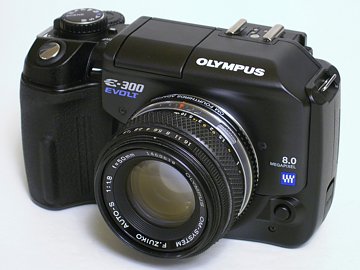
| |
|
The OM gurus say there were various versions of the 1.8/50 lens. The latest, optically best, version has Japan engraved on the front ring. All samples with the OM lens were taken in the aperture priority mode, at ISO 200, and with use of ESP metering. Obviously, I had to use stepped-down metering and manual focus. The source of light were my living room lamps in paper shades; no special light arrangements were made. White balance was determined by reference ("one touch"). When a lens designed for a 35-mm film camera is used on a digital one, with image sensor smaller than film frame, the mirror may cut off the outer parts of the light beam on its way to the viewing screen (and, in the E-300 and E-1 at least, to the exposure meter). The meter "sees" less light than the CCD sensor will see, and this will lead to under-metering, or overexposure. This happens only at wider apertures, when the light beam is wider. The overexposure can be dealt with by means of exposure compensation, which may be different for different lenses. For the 1.8/50 OM Zuiko lens the compensation required is quite slight: -0.3 EV at F/1.7; no compensation is needed at F/2.8 and beyond. Images on the left are full frames, reduced and slightly re-sharpened, to give you an idea about the exposure accuracy and image tonality. Red frames show locations of fragmentary 1:1 samples, cut from originals and re-saved at low JPEG compression, without any manipulation. These 1:1 samples are shown on the right. Note that the 1:1 samples are quite large when viewed on your computer screen. If your screen resolution is 96 dpi (which is typical), the samples are enlarged about 2× compared to a relatively large, 30×40 cm (12×16") print. This simply means that the print will be much sharper; smaller prints — even more so. | ||
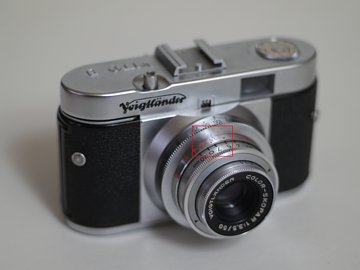
|
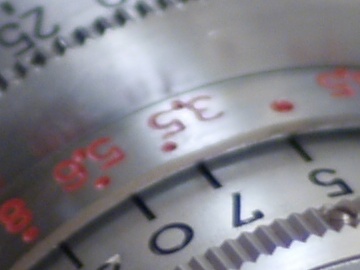
| |
|
OMZ: F/1.8, 1/30 s (-0.3 EV compensation), ESP metering.
This is the only image with exposure compensation applied, for reasons explained above. The depth of field is very shallow (lens was focused at the "7" digit), but even that aside, the image is generally quite soft and contrast is low. | ||
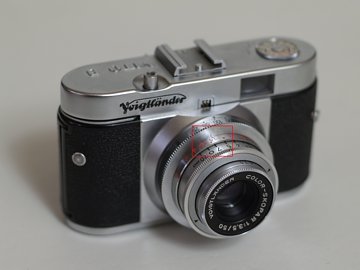
|
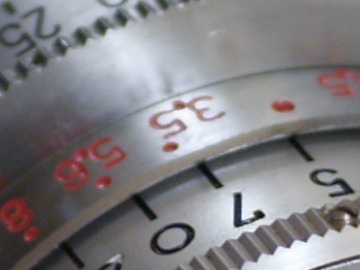
| |
| OMZ: F/2.8, 1/15 s. The contrast is markedly better, so is the sharpness. Note DOF still quite shallow. | ||
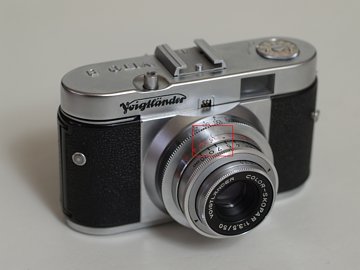
|
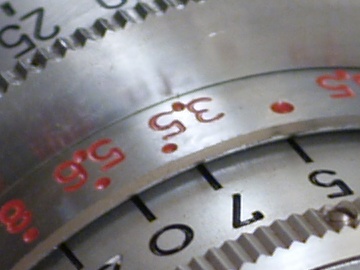
| |
| OMZ: F/4.0, 1/8 s. Looks like contrast already peaked out at F/2.8, no change here, but the "7" digit is a bit sharper at F/4.0, not to mention more DOF. | ||
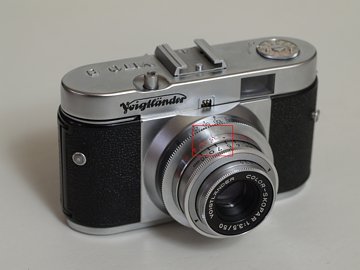
|
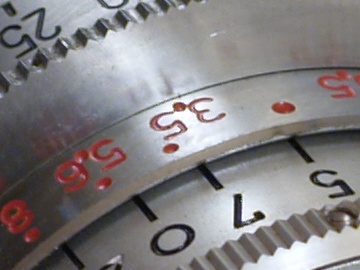
| |
| OMZ: F/5.6, 1/5 s. No improvement in focused sharpness, just the expected further increase in depth of field. | ||
|
For comparison, a picture taken with the 14-45 mm zoom lens bundled with the E-300 at the same conditions, although from a slightly different angle (because of shorter focal length, I moved the camera a little bit closer). | ||
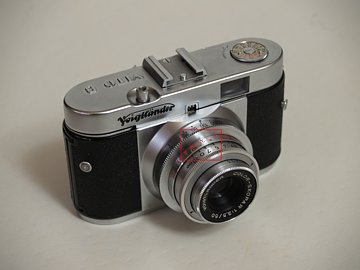
|
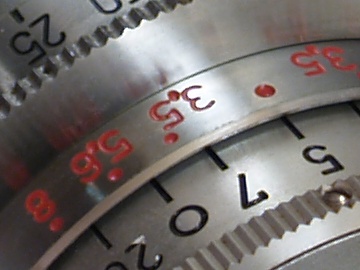
| |
| Zuiko Digital 14-45 mm at F=45 mm: F/5.6, 0.4 s. Slightly less contrast and sharpness — seems just a tad behind the prime 50 mm F/1.8 at the same aperture; visible vignetting (image fall-off in corners). | ||
|
Except for some vignetting (while visible here at full aperture, it should not be much of a problem in most shooting situations), the 14-45 mm zoom at F/5.6 delivers almost the same sharpness and contrast as the 1.8/50 OM Zuiko closed down to the same aperture. This is not too shabby. While the 14-45 mm Zuiko Digital is an "economy" lens, it still costs $250 or so, while a used 1.8/50 prime OMZ can be bought at one-tenth of the price. This is what you pay for zooming and autofocus. As a rule, optically, a zoom is no match for a decent prime lens — but in this case the latter has been designed for a larger format, with larger field and lower resolution requirements. Obviously, when stepped down by one or two notches, the zoom lens will perform visibly better (sharper, no vignetting — see my E-300 image samples). | ||

|
My other articles related to the |
|
Evolt® and Olympus® are registered trademarks of Olympus Corporation.
This page is not sponsored or endorsed by Olympus (or anyone else) and presents solely the views of the author. |
| Home: wrotniak.net | Search this site | Change font size |
| Posted 2005/01/25; last updated 2006/04/29 | Copyright © 2005-2006 by J. Andrzej Wrotniak. |